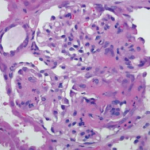In our patient, an endovascular approach was chosen to avoid the need for thoracotomy; decisions must be tailored to the specifics of the patient.
Because this is an uncommon presentation for ANCA-associated vasculitis, formal guidelines for surgical interventions are lacking. However, one may extrapolate from other large-vessel vasculitis guidelines when ANCA-associated vasculitis involves large vessels requiring surgical or endovascular intervention.
Evidence suggests that adequate immunosuppression can improve long-term vessel patency in large-vessel vasculitis, particularly in endovascular procedures.15 Therefore, optimizing immunomodulatory therapy, both before and after the intervention, is essential to minimize restenosis and enhance long-term outcomes (see Table 1).
Conclusion
Pulmonary artery involvement in GPA is a rare but significant manifestation. Despite clinical treatment, fibrotic stenosis may persist, necessitating surgical interventions, such as pulmonary artery stenting, for optimal outcomes. Early diagnosis and a multidisciplinary approach are critical to manage these complex cases effectively.
 Sambhawana Bhandari, MD, is an assistant professor of medicine in the Division of Rheumatology at Washington University (WashU) School of Medicine in St. Louis. She recently completed her rheumatology fellowship at WashU and joined the faculty as a clinical rheumatologist. Her clinical and research interests focus on the intersection of rheumatology and oncology, as well as connective tissue disease-associated interstitial lung disease.
Sambhawana Bhandari, MD, is an assistant professor of medicine in the Division of Rheumatology at Washington University (WashU) School of Medicine in St. Louis. She recently completed her rheumatology fellowship at WashU and joined the faculty as a clinical rheumatologist. Her clinical and research interests focus on the intersection of rheumatology and oncology, as well as connective tissue disease-associated interstitial lung disease.
 Colin Diffie, MD, is an associate professor of medicine in the Division of Rheumatology at Washington University in St. Louis. He currently serves as the head of the Rheumatology Department at the John Cochran VA Medical Center and is the co-director of the Vasculitis Clinic at WashU.
Colin Diffie, MD, is an associate professor of medicine in the Division of Rheumatology at Washington University in St. Louis. He currently serves as the head of the Rheumatology Department at the John Cochran VA Medical Center and is the co-director of the Vasculitis Clinic at WashU.
Table 1: Description of Cases Described in Literature
| SN | Age | Gender | AAV Symptoms | Diagnosis | Pulmonary stenosis (symptoms, diagnosis) | Treatment | Prognosis | Authors |
|---|---|---|---|---|---|---|---|---|
| 1 | 62 | F | ENT: recurrent nasal congestion with bloody discharge and sinus infections, progressive left-sided hearing loss, recurrent otitis media requiring tympanoplasty, and arthralgia. Other large vessel involvement: No | P-pattern ANCA and MPO antibodies | Within the same year of diagnosis. Symptoms: dyspnea, worsening leg swelling. CT PA: ill-defined soft tissue thickening surrounding the right and left main PAs with moderate stenosis. PET- CT: infiltrative tissue at the PA outflow tract and increased metabolic activity in the proximal PAs. Echo: severe pulmonary hypertension with an estimated RVSP of 102 mmHg, right ventricular dilation. RHC: proximal right PA stenosis with a peak gradient of 24 mmHg and PASP of 72 mmHg, with a mean PA pressure of 32 mmHg | Prednisone, avacopan, rituximab | Progression on immunosuppression, requiring PA stenting | Our case |
| 2 | 37 | F | ENT: bilateral otitis media, nasal and sinus pain and discharge, subglottic stenosis. Pulmonary: hemoptysis, pulmonary infiltrates and nodules. Other large vessel involvement: No | C-pattern ANCA and anti-proteinase 3 (PR3) antibodies. Diagnosed with open lung biopsy: granulomatous inflammation and vasculitis | 4 years from initial diagnosis Symptoms: dyspnea, fatigue Pulmonary artery (PA) angiogram: narrowing of the distal main and right PAs. Intravascular ultrasound: smooth walled thickening of the primary branches of the PAs. | Methotrexate and prednisone, then cyclophosphamide | No progression of stenosis | Clark et al. |
| 3 | 62 | F | ENT, pulmonary: NA Third-degree atrioventricular block PA stenosis worsening on immunosuppressive therapy Other large vessel involvement: No | C-pattern ANCA, ELISA NA Diagnosed with a biopsy of interauricular septal mass: pathology NA | 6 years from initial diagnosis Symptoms: dyspnea PA angiogram: short and severe stenosis of the main PA, 10 mm above the pulmonary valve Histopathology of the PA: arteritis with oedema and diffuse lymphocytic and histiocytic infiltration | PA stenting, immunosuppression | Progression on immunosuppression, requiring PA stenting | Colin et al. |
| 4 | 34 | F | ENT: collapse of nasal bones, chronic facial pain, otitis media, deafness, tracheal stenosis Pulmonary: lung cavitation Other large vessel involvement: No | C-pattern ANCA and anti-PR3 antibodies detected by ELISA Open lung biopsy: bronchocentric granulomatosis | 6 years from initial diagnosis Symptoms: dyspnea, syncope CT PA: smooth soft tissue filling defects within the left and right main PAs, extending on the right from its origin, into the right upper and lower lobe PAs; stenosis of right main PA; focal severe stenosis of the left main PA. PA angiogram: 2.5–3 cm severe stenosis in the right main PA, extending to the origins of right upper and lower lobe PAs with moderate stenosis of right lower lobe PA branches and severe focal stenosis of proximal left main PA. Echo: pulmonary hypertension, PASP 90 mmHg RHC: increase in right atrial (27/12 mmHg), right ventricular (86/19 mmHg), main PA(86/12 mmHg) and a normal distal left PA pressure (20 mmHg). 66 mmHg systolic gradient across the left main PA stenosis. Histopath of hard adherent matter in main PA: PA fibrosis with dense lymphoid infiltrate, plasma cells and macrophages; some foamy; areas of necrosis surrounded by palisaded histiocytes with focal micro-abscess formation | Surgical pulmonary “embolectomy”: of hard adherent matter | NA | Doyle et al. |
| 5 | 23 | M | ENT: sinusitis Other: upper limb ischemia, renal impairment Other large vessel involvement: No | C-pattern ANCA and anti-PR3 antibodies detected by ELISA Renal biopsy: focal necrotizing glomerulonephritis | 3 years from initial diagnosis Symptoms: dyspnea CT PA: large circumferential pericardial effusion abutting a severely stenosed left pulmonary artery Cardiac MRI: substantial vessel wall thickening causing mild stenosis at the junction of the distal main and proximal right PAs and more severe stenosis of the proximal left PA | Prednisone, cyclophosphamide, azathioprine, rituximab | Complete resolution of the PA stenosis, with minimal residual vessel wall thickening | Jain et al. |
| 6 | 22 | F | NA; eye, ear, nose symptoms Ocular tumor, coronary artery ostial stenosis Other large arteries involved: ascending aorta, internal thoracic arteries | NA | 21 years from initial diagnosis 21 years from initial diagnosis No other studies or biopsies available | NA | Restoration of right ventricular outflow tract to bilateral PA and coronary-coronary bypass | Murakami et al. |
| 7 | 52 | F | Other symptoms NA Other large vessel involvement: No | MPO-ANCA positive | Duration NA Symptoms: dyspnea CT PA: stenosis of the right main PA at the entrance. PA angiogram: severe stenosis of both the right main and left main PAs Echo: pulmonary hypertension, PASP 90 mmHg RHC: elevated right ventricular systolic pressure (116 mmHg) Histopath of the stenosed PA: non-specific inflammation with granulomatous lesions. Inflammation seen in both the external laminae and tunica media of the PA wall. | Stenotic lesions were resected, and the PA were reconstructed No data on Stenotic lesions were resected, and the PA were reconstructed No data on immunosuppression used | Patient remained asymptomatic 2 years after surgery | Nakayama et al. |
| 8 | 39 | F | ENT: sinusitis, otitis media, saddle nose deformity, epistaxis, tracheitis Other large vessel involvement: No | NA | Diagnosis synchronous with GPA diagnosis Symptoms: chest tightness PA angiogram: narrowing of the proximal portion of the right PA Thoracotomy: thickening and rigidity of the PA just distal to the pulmonic valve and also the right PA Histopath of the PA: necrotizing granulomatous inflammation with vasculitis | NA | NA | Sasaki et al. |
| 9 | 51 | M | Other large vessel involvement: ascending aorta | MPO-ANCA positive FDG/PET: remarkable vessel wall thickening with focally high FDG uptake in the distal main PA and proximal branches and bilateral nasal cavity and nasopharynx;increased FDG uptake within the wall of the ascending aorta; mostly indicative of granulomatous inflammation | Diagnosis synchronous with GPA diagnosis CT PA: vessel wall thickening causing severe luminal stenosis of both proximal left and right PA, and mild aortic wall thickening in the ascending aorta with no evidence of stenosis Echo: pulmonary hypertension, PASP 95 mmHg | Methylprednisolone, cyclophosphamide | PA stenosis completely resolved per ECHO | Zhang et al. |
References
- Jennette JC, Falk, RJ, Bacon PA, et al. 2012 revised International Chapel Hill Consensus Conference Nomenclature of Vasculitides. Arthritis Rheum. 2013 Jan;65(1):1–11.
- Clark T, Hoffman GS. Pulmonary artery involvement in Wegener’s granulomatosis. Clin Exp Rheumatol. 2003 Nov–Dec;21(6 Suppl 32):S124–126.
- Monghal V, Puéchal X, Smets P, et al. Large-vessel involvement in ANCA-associated vasculitis: A multicenter case-control study. Semin Arthritis Rheum. 2024 Aug;67:152475.
- Nakayama H, Uchida K, Sim JJ, et al. A case of pulmonary arteritis with stenosis of the main pulmonary arteries with positive myeloperoxidase-antineutrophil cytoplasmic autoantibodies. Respirology. 2000 Dec;5(4):381–384.
- Zhang J, Wang P, Qin C, et al. ANCA (antineutrophil cytoplasmic antibody)-associated pulmonary vasculitis causing pulmonary artery stenosis: The value of multimodality imaging in the clinical workup. Circ Cardiovasc Imaging. 2021 Jul;14(7):e012484.
- Colin GC, Pouleur A-C, Lefebvre C, Ghaye B. Unexpected ‘pulmonary hypertension’ in a patient with granulomatosis with polyangiitis. Eur Heart J. 2014 Nov 21;35(44):3141.
- Doyle DJ, Fanning NF, Silke CS, et al. Wegener’s granulomatosis of the main pulmonary arteries: Imaging findings. Clin Radiol. 2003 Apr;58(4):329–331.
- Jain P, Ruchin P, Suttie J. Proximal pulmonary artery stenosis: A rare manifestation of granulomatosis with polyangiitis. Lancet. 2016 Jun;387(10035):2349–2350.
- Murakami A, Motomura N, Takaoka T, et al. Coronary-coronary bypass and pulmonary artery reconstruction related to Wegener granulomatosis in a 22-year-old woman. J Thorac Cardiovasc Surg. 2003 Mar;125(3):721–723.
- Case records of the Massachusetts General Hospital. Weekly clinicopathological exercises. Case 31-1986. A 39-year-old woman with stenosis of the subglottic area and pulmonary artery. N Engl J Med. 1986 Aug 7;315(6):378–387.
- Maz M, Chung SA, Abril A, et al. 2021 American College of Rheumatology/Vasculitis Foundation Guideline for the Management of Giant Cell Arteritis and Takayasu Arteritis. Arthritis Rheumatol. 2021 Aug;73(8):1349–1365.
- Qin L, Hong-Liang Z, Zhi-Hong L, et al. Percutaneous transluminal angioplasty and stenting for pulmonary stenosis due to Takayasu’s arteritis: Clinical outcome and four-year follow-up. Clin Cardiol. 2009 Nov;32(11):639–643.
- Perera AH, Youngstein T, Gibbs RGJ, et al. Optimizing the outcome of vascular intervention for Takayasu arteritis. Br J Surg. 2014 Jan;101(2):43–50.
- Saadoun D, Lambert M, Mirault T, et al. Retrospective analysis of surgery versus endovascular intervention in Takayasu arteritis: A multicenter experience. Circulation. 2012 Feb 14;125(6):813–819.
- Gülcü A, Gezer NS, Akar S, Akkoç N, Önen F, Göktay AY. Long-term follow-up of endovascular repair in the management of arterial stenosis caused by Takayasu’s arteritis. Ann Vasc Surg. 2017 Jul;42:93–100.

